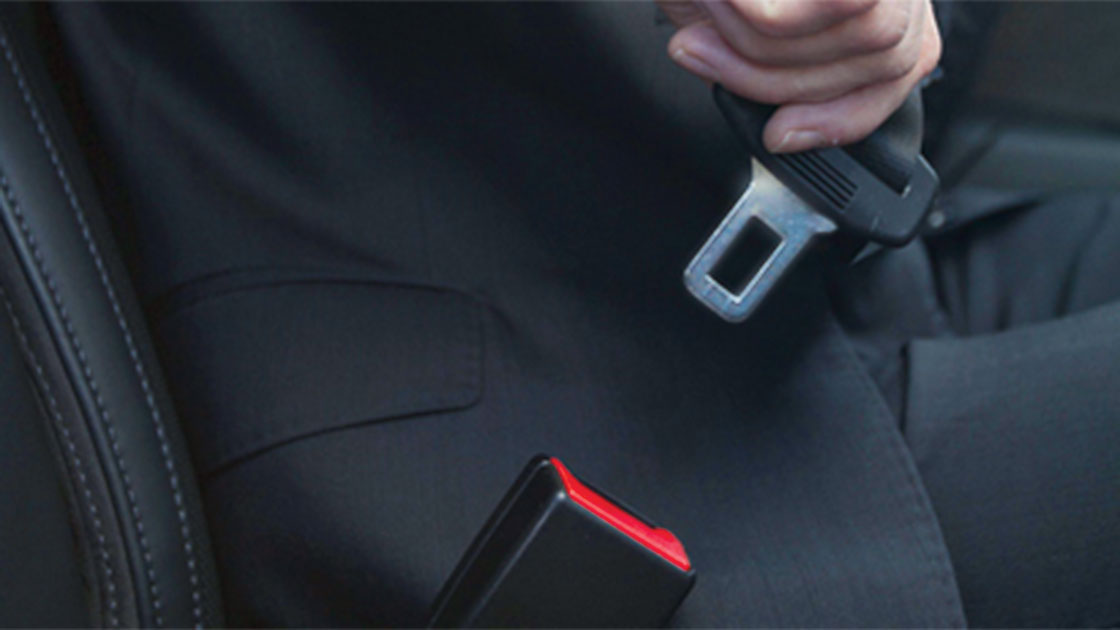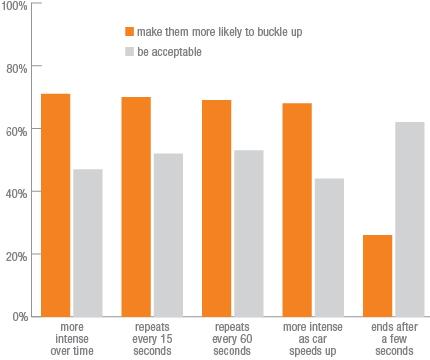Status Report, Vol. 48, No. 1 
How to turn part-time belt users into full-time users is an issue that has dogged policymakers for many years. Even though belt use is at a record 86 percent, more than half of the people who die in passenger vehicle crashes each year are unbelted. Last year's passage of the federal highway reauthorization bill opens the door wider for technological solutions to the problem. Among in-vehicle technologies to encourage belt use, results of a new Institute survey show that most motorists support enhanced belt reminders that are more persistent and intense than most U.S. vehicles have now, but belt interlocks still would be a hard sell.
Part-time belt users say these belt reminder strategies would...


Driver acceptance is crucial because early attempts to use in-vehicle technology to boost belt use backfired. In the early 1970s when belt use was very low, the National Highway Traffic Safety Administration (NHTSA) began requiring auditory and visual reminders in new vehicles to activate for at least a minute if front-seat occupants were unbuckled when a vehicle was started. This approach was followed by a 1973 mandate that all new cars that didn't have airbags or other passive restraints — and few did — be equipped with a belt interlock that prevented starting a car if the front-seat occupants were unbelted.
Public reaction to the interlocks was so negative that in 1974 Congress eliminated the standard and banned NHTSA from requiring belt interlocks or even allowing automakers to use them to meet federal safety standards. Congress also restricted the standard for belt reminders, specifying that NHTSA could only require auditory belt reminders with warning chimes or buzzers lasting 8 seconds or less. Automakers were free to voluntarily use reminders with more persistent warnings, but few did so until recently. Ford was first to equip vehicles with enhanced reminders, beginning with some 2000 models (see "Automakers are adding more persistent reminders to buckle up," March 27, 2004). Today, most new vehicles sold in the United States have enhanced reminders for the driver and front passenger that exceed federal requirements. Among 2012 models, 91 percent had enhanced belt reminder systems for the driver, while 77 percent had them for right-front passengers. Institute studies have shown that driver belt use is higher and fatality rates are lower in vehicles with enhanced belt reminders than in vehicles without them (see "Safety belt reminder system in late-model Fords boosts buckle-up rate," Feb. 9, 2002; "Belt reminders in Hondas are persuading motorists to buckle up," June 13, 2006; and "Effective belt reminders don't need to be relentless," March 6, 2012). The European New Car Assessment Programme (Euro NCAP) awards ratings points to vehicles with what it calls intelligent belt reminders. The main criteria are visual and auditory warnings that last for at least 90 seconds, either continuously or intermittently. For example, under Euro NCAP rules, if a driver is unbelted and the car reaches a set speed, a light might flash and a chime might sound for 15 seconds every 30 seconds. The cycle would repeat at least six times unless the driver buckles up, so the warning would be present for the first three minutes of the trip. In contrast, many enhanced reminders in U.S. vehicles quit earlier, so drivers might ignore them altogether. MAP-21, the 2012 highway reauthorization law, allows NHTSA to strengthen minimum requirements for belt reminders. The agency also can permit but not require automakers to use belt interlocks to comply with some regulations (see "LATCH, belt reminders get lift," Sept. 20, 2012). "MAP-21 provides an opening for NHTSA to revisit technologies to increase belt use," says Anne McCartt, Institute senior vice president for research and an author of the new study. "Click It or Ticket publicity and enforcement campaigns and state primary belt use laws have sharply raised belt use since the 1970s and saved thousands of lives, but the success has plateaued in recent years. Studies show that enhanced belt reminders encourage people to buckle up. Our findings should help NHTSA and automakers sort out the most promising technologies that drivers would accept." A good starting point would be to adopt European-style belt reminders. European research shows that belt use in vehicles with reminders meeting Euro NCAP requirements is about 12 percentage points higher than belt use in vehicles without them. Observed driver belt use is about 95 percent in vehicles with these European-style reminders. Among models sold in the U.S. with enhanced reminders, only about a third would meet Euro NCAP requirements, the Institute estimates.
